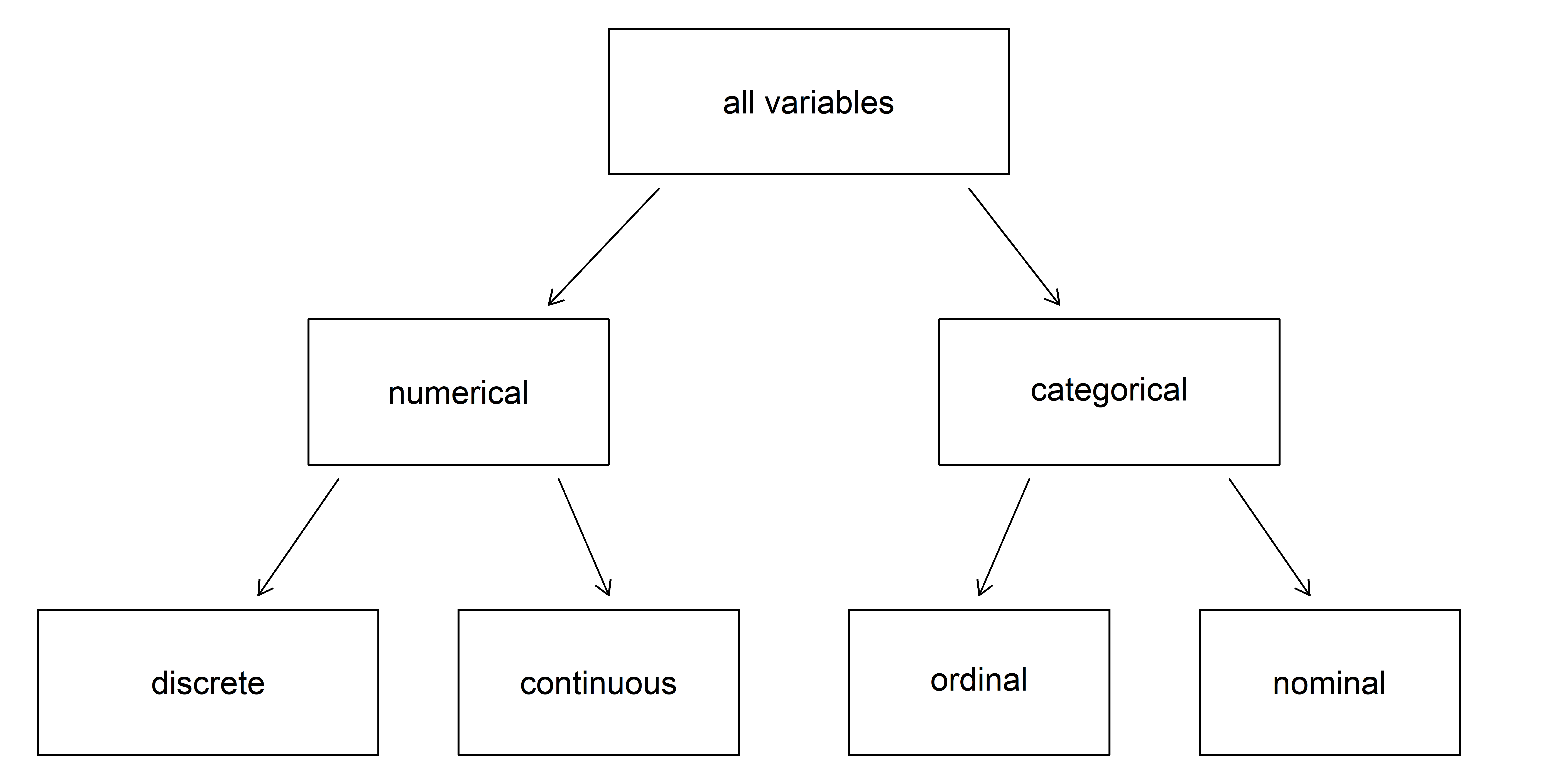03:00
Principles of Inference
STA 101L - Summer I 2022
Raphael Morsomme
Welcome
Announcements – presentations
- Presentations are < 5 minutes
- QA – ask a question!
- Discussion
Presentations

Announcements
- Homework 5 due Sunday
- Wednesday’s schedule: 3:30-4:15 lecture; 4:15-5:45 (Roy’s OH)
Recap – 1st half of course
Types of data and studies
Visualization and numerical summaries
Regression models
linear regression
logistic regression
model selection
Types of data

Breakdown of variables into their respective types.
Source: IMS
Outline – 2nd half of course
Statistical inference
proportions
means
linear and logistic regression
Outline
Statistical inference
Five cases
Hypothesis test
Confidence interval
A first glimpse of modern statistics
Statistical inference
Population parameters
We want to learn about some (unknown) parameter of some population of interest from a (small) sample of observations
- Examples of parameters: proportion of vegetarian among Duke students, average weight gained by US adults during the Covid-19 pandemic, etc.
- In the remainder of the course, we will always assume that we have a random sample of the population.
Group exercise - identify the parameter
Exercise 11.1
Statistical inference
Inference: estimating the population parameter from the sample.
Statistical inference: estimating the population parameter from the sample and rigorously quantify our certainty in the estimate.
Statistic
Statistic: any function of some data
- e.g., average, median, iqr, maximum, variance, etc.
Sample statistic: a statistic computed on the sample
Summary statistic: a statistic used to summarize a sample
Test statistic: statistic used for statistical inference
Estimating a parameter
To estimate a population parameter, we can simply
obtain a representative sample, and
use the corresponding sample statistic as an estimate
- to estimate the median age of Duke students, simply collect a sample of students and compute their median age.
Certainty matters
A single point (the sample statistic) does not indicate how certain we are in our estimate.
If we have a large sample, we can be pretty confident that our estimates will be close to the true value of the parameter,
if we have a small sample, we know that our estimate may be far from the truth.
e.g. free throws in basketball, penalty kicks in soccer.
Statistical inference
Framework to make rigorous statements about uncertainty in our estimates
confidence intervals
- range of plausible values for the population parameter
hypothesis tests
- evaluate competing claims
Five cases
Case 1 – Single proportion
What is the proportion of vegetarians among Duke students?
Population parameter: proportion of vegetarians among Duke students \((p)\)
Sample statistic: proportion of vegetarian in the sample \((\hat{p})\)

Confidence interval: a range a plausible values for the population parameter \(p\)
- for example, \((0.31, 0.43)\)
Hypothesis test: is the proportion of vegetarians among Duke students \(0.5\)?
- \(H_0:p=0.5, \qquad H_a:p\neq0.5\)
Case 2 – Difference between two proportions
Is the proportion of vegetarians the same among Duke undergraduate and graduate students?
Population parameter: difference between the proportion of vegetarians among Duke undergraduate and graduate students \((p_{diff} = p_{undergrad}-p_{grad})\)
Sample statistic: difference in proportion of vegetarians in the sample \((\hat{p}_{diff} = \hat{p}_{undergrad} - \hat{p}_{grad})\)
Confidence interval for \(p_{diff}\): \((-0.05, 0.08)\)
Hypothesis test: is the proportion of vegetarians the same among Duke undergraduate and graduate students?
- \(H_0:p_{diff}=0, \qquad H_a:p_{diff}\neq0\)
Case 3 – Single mean
How much time do Duke students sleep on average per night?
Population parameter: mean amount of time that Duke students sleep per night \((\mu)\)
Sample statistic: average amount of time slept in the sample \((\bar{x})\)

Confidence interval for \(\mu\): \((5.5, 7.5)\)
Hypothesis test: Do Duke students sleep on average \(8\) hours per night?
- \(H_0:\mu=8, H_a:\mu\neq8\)
Case 4 – Difference between two means
Do Duke undergraduate and graduate students sleep on average the same amount of time per night?
Population parameter: difference between the mean amount of time that Duke undergraduate and graduate students sleep per night \((\mu_{diff} = \mu_{undergrad}-\mu_{grad})\)
Sample statistic: difference between the two sample averages \((\bar{x}_{diff} = \bar{x}_{undergrad} - \bar{x}_{grad})\)
Confidence interval for \(\mu_{diff}\) : \((-0.5, 1)\)
Hypothesis test: Do Duke undergraduate and graduate students sleep on average the same amount of time per night?
- \(H_0:\mu_{diff}=0, H_a:\mu_{diff}\neq0\)
Case 5 – Linear regression
What is the relation between fuel consumption in the city and on the highway?
Population parameter: the coefficient \(\beta_1\) is the equation \(\text{hwy} \approx \beta_0 + \beta_1 \text{cty}\).
Sample statistic: the least-square estimate \(\hat{\beta}_1\).
Confidence interval for \(\beta_1\): \((1.05, 1.2)\)
Hypothesis test: are the variables \(\text{cty}\) and \(\text{hwy}\) independent?
- \(H_0:\beta_1=0, H_a:\beta_1\neq0\)
Hypothesis tests
The null hypothesis and the alternative hypothesis
Two competing hypotheses:
- the null hypothesis \(H_0\)
- “nothing is going on”: there is no effect, no difference
- the alternative hypothesis \(H_a\)
- “something is going on”: there is an effect, there is a difference
Example
Consider the 2nd case (difference in proportion of vegetarians between undergrad and grad students).
\(H_0:\) the proportion of vegetarian is the same among undergraduate and graduate students (“nothing is going on”) $$ H_0: p_{diff}=p_{undegrad}-p_{grad}=0
\[ \]
H_a: p_{undegrad}=p_{grad} $$
\(H_a:\) the proportion of vegetarians among undergraduate and graduate students is not the same (“something is going on”). $$ H_0: p_{diff}=p_{undegrad}-p_{grad}
\[ \]
H_a: p_{undegrad}p_{grad} $$
More examples
- Are the Covid-19 vaccines equally effective?
- \(H_0\): the vaccines are all equally effective; \(H_a\): the vaccines are not all equally effective.
- Does caffeine consumption affect student participation in class
- \(H_0\): caffeine consumption does not affect student participation; \(H_a\): caffeine consumption affects student participation.
- Are men and women paid equally in the workplace?
- \(H_0\): men and women are paid equally; \(H_a\): men and women are not paid equally.
- Have Duke students gained weight since the start of the Covid-19 pandemic?
- \(H_0\): Duke student have not gained weight; \(H_a\): Duke students have gained weight.
04:00
Natural variability
Go back to the 2nd case and suppose that \(H_0\) is true.
- We’ll probably still observe a small difference between undergrad and grad students in the sample.
Now suppose that \(H_a\) is true.
- We’ll probably observe a larger difference in the sample,
- but we might also observe no difference at all,
- or observe a different in the wrong direction!
Natural variability and hypothesis tests
We’ll always observe a difference
Observing a difference in the sample is not sufficient to reject \(H_0\). When we collect a sample, there always is some natural variability inherent to the data.
Determining whether the observed difference is due to natural variation or provides convincing evidence of a true difference between the two groups is at the heart of hypothesis tests.
Group exercise - convincing evidence
Suppose we have a sample of Duke students with the same number of undergraduates and graduates, and \(\hat{p}_{diff} = \hat{p}_{undergrad} - \hat{p}_{grad} = 0.6 - 0.4 = 0.2\). For what sample sizes \(n\) do you intuitively feel that the observed difference provides convincing evidence that the two groups are different?
- \(n=10\) (5 undergrad and 5 grad students)
- \(n=20\) (10 undergrad and 10 grad students)
- \(n=50\) (…)
- \(n=100\)
- \(n=250\)
- \(n=500\)
- \(n=1000\)
03:00
Confidence interval
Confidence interval
CI: range of plausible values for the population parameter.
There always is natural variability in the data.
If we draw a second sample from the population, the two samples will differ and the sample statistics will not be the same (e.g., \(\hat{p}_1\neq\hat{p}_2\), \(\bar{x}_1\neq\bar{x}_2\) and \(\hat{\beta}^{(1)}_1\neq\hat{\beta}^{(2)}_1\)).
There is thus no reason to believe that the sample statistic in the first sample is exactly equal to the population parameter (e.g. \(\hat{p}_1 = p\) and \(\bar{x}_1=\mu\)).
Examples
What is the approval rate of the US president?
What proportion of Duke students are vegetarian?
How much weight have US adults gained since the start of the Covid-19 pandemic?
CI: range of plausible values based on a sample.
Modern statistics
Classical and modern approach
We will learn two approaches to statistical inference
- classical
- pen and paper, pre-computer era
- based on simple mathematical formula
- requires the data to satisfy certain conditions
- modern
computer-intensive
models the variability in the data by repeating a procedure many times (for-loop)
always applicable
A first glimpse of modern statistics for HT
Individual exercise – simulation
Suppose you flip a coin 100 times and count the number of heads. In the first lecture, you were asked to identify what number of heads would make you doubt that the coin is fair.
We will run an experiment together to see if your gut feeling was correct.
Use the following commands to simulate 100 flips of a coin and count the number of heads. Repeat the experiment 5 times, keeping track of the number of heads.
02:00
For-loop
The following for-loop does the previous experiment efficiently!
set.seed(0)
results <- tibble(prop_heads = numeric()) # empty data frame to collect the results
for(i in 1 : 1e3){ # repeat the experiment 1,000 times
flips <- rbernoulli(100, p = 0.5) # flip 100 coins (sample)
n_heads <- sum(flips) # count the number of heads
prop_heads <- n_heads / 100 # proportion of heads (sample statistic)
results <- results %>% add_row(prop_heads) # add the sample statistic to the data frame `result`
}Distribution of the sample statistic \(\hat{p}\) when \(H_0\) is true.

Population and parameter
Population and parameter first
Always start by defining the population and the parameter of interest.
Population: flips of the coin
Parameter: probability that a flip is head
Null and alternative hypotheses
\(H_0:p=0.5\) (the coin is fair)
\(H_a:p\neq0.5\) (the coin is not fair)
Like jurors in the justice system
\(H_0:\) innocent (the coin is fair)
\(H_a:\) guilty (the coin is not fair)
Question: do the facts (the sample) provide sufficient evidence to reject the claim that the defendant is innocent (that the coin is fair)?
If so, we reject \(H_0\),
otherwise, we fail to reject \(H_0\).
Never accept the null hypothesis
We never accept the null hypothesis! We only reject or fail to reject it.

Two outcomes
Suppose the sample consists of 55 heads of 100 flips
\(\Rightarrow\) such sample is plausible under \(H_0\); the observed data do not provide strong evidence against the null hypothesis; we fail to reject the claim that the coin is fair
- The coin might be unfair, but the data do not provide strong evidence against fairness.
Now suppose that out of 100 flips, you observe 65 heads.
\(\Rightarrow\) this result is extremely unlikely under \(H_0\); the observed data provide strong evidence against the null hypothesis; we reject the claim that the coin is fair.
- The coin might be fair, but a fair coin will rarely give \(65\) heads out of \(100\) flips.
A first glimpse of modern statistics for CI
Natural variability
Due to the natural variability of the data, each sample is different.
In practice we only get to observe a single sample. But if we could observe other samples,
they would all be a bit different
\(\Rightarrow\) the sample statistics would also be different
\(\Rightarrow\) the estimates would also be different.
Sample-to-sample variability
If the samples are very different
- we say that the sample-to-sample variability is large.
- we would not be very confident in the estimate
If the samples are all similar
- we say that the sample-to-sample variability is small
- we would be confident that the estimate is close to the truth
From a single sample to bootstrap samples
Problem: we only get to observe a single sample!
Solution: Use the sample to approximate the population and take repeated samples from the estimated population to simulate many samples.
- Equivalent to sampling with repetition from the sample.

Source: IMS
From bootstrap samples to CI
Computing the sample statistic of each bootstrap sample provides its sampling distribution.
To construct a 90% CI of some parameter, we simply identify the 5th and 95th percentiles of the sampling distribution of the corresponding sample statistics.
- the 5th and 95th percentiles of the sampling distribution of the median give the 90% CI for the median.
Interpretation: “We are 90% confident that the interval captures the true value of the population parameter”.
Little variability \(\Rightarrow\) narrow CI
Little variability in the data
\(\Rightarrow\) little sample-to-sample variability
\(\Rightarrow\) little variability between bootstrap samples
\(\Rightarrow\) sampling distribution of mean/proportion is concentrated
\(\Rightarrow\) CI is narrow.
Much variability \(\Rightarrow\) large CI
Much variability in the data
\(\Rightarrow\) much sample-to-sample variability
\(\Rightarrow\) much variability between bootstrap samples
\(\Rightarrow\) sampling distribution of mean/proportion is diffuse
\(\Rightarrow\) CI is large.
Computing bootstrap CI
d <- ggplot2::mpg
results <- tibble(mean = numeric(), sd = numeric())
for(i in 1 : 1e3){
d_boot <- slice_sample(d, n = nrow(d), replace = TRUE) # sampling from the sample with replacement
results <- results %>%
add_row(mean = mean(d_boot$cty), sd = sd(d_boot$cty)) # sample statistics of the bootstrap sample
}

Computing the CI
06:00
Group exercise - bootstrap CI
Re-use the code from the previous slide to compute a 90% bootstrap CI of the variance of cty in the population.
03:00
Recap
Recap
Statistical inference
Five cases
single proportion
difference between two portions
single mean
difference between two means
regression parameters
Hypothesis test
Confidence interval
A first glimpse of modern statistics
